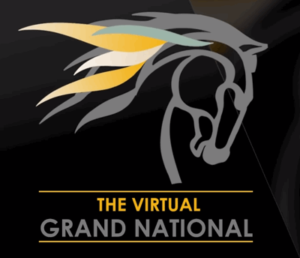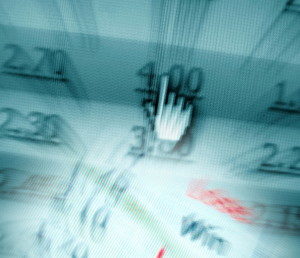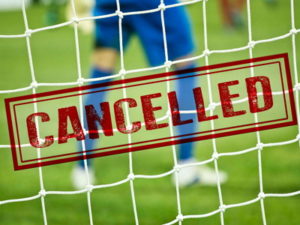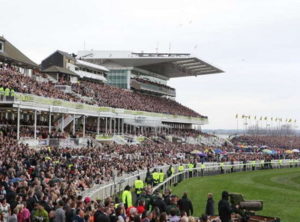Virtual Grand National 2025 – 12th April, Live On ITV
 The development in technology over the years has allowed a number of things to happen in the world of sports. From the Video Assistant Referee being introduced in football to reviews being called in cricket, technological advancements have changed the face of televised sport. There’s also been an intriguing development in horse racing, with the virtual Grand National topping the bill.
The development in technology over the years has allowed a number of things to happen in the world of sports. From the Video Assistant Referee being introduced in football to reviews being called in cricket, technological advancements have changed the face of televised sport. There’s also been an intriguing development in horse racing, with the virtual Grand National topping the bill.
The ‘World’s Greatest Steeplechase’ is one of the most watched horse races on the planet, also inviting many bets on what might happen. The desire to get some sort of head’s up on what will occur at Aintree led the Manchester-based Inspired Entertainment to create an algorithm that allows them to use numerous data points to play the race out before it actually happens.
The virtual version of the race has actually been since 2017 but came to fore in 2020 when it featured in place of the main race that was cancelled due to the coronavirus pandemic. On this page we have collated the information about the race itself, it’s history, how it works and what it’s like to watch.
Where Is It And How Do You Watch It
| Date | Where | Time | Runners | TV |
|---|---|---|---|---|
| 13/04/2024 | Inpired Entertainment | ~3pm | 40 | ITV |
Virtually the race is held at the same Aintree course we all know and love. In the real world the race will be run at the Manchester headquarters of Inspired Entertainment, a company that develop virtual sports feeds and have run the race in the previous 4 years.
The race is always broadcast by the TV provider for the main Grand National race, this year that is ITV. It has previously been run a couple of hours before the race as a preview of the main event for the TV pundits to chat about. Many people who tune in only to see the main race would be unaware it has even been going since 2017.

The race has another purpose too though. It is designed using all the data the developers can get about the real runners in the hope it will be a genuine prediction of what would happen in the real race. In the past it has been astonishingly accurate in that role, see history and previous winners section for more about that.
In 2020 it was strangely the feature event and was a bit of history in the making, with around 4.5 million people tuning in to watch what is in effect a computer running a digital horse race.
Can You Bet On The Virtual National?
 Bookmakers love virtual sports because they’re able to run them as regularly as they like and nothing can interfere with them. Bad weather won’t have an effect on whether a virtual race is able to take part or not, nor will runners drop out of the race at the last minute. Yet are things slightly different when it comes to the virtual Grand National?
Bookmakers love virtual sports because they’re able to run them as regularly as they like and nothing can interfere with them. Bad weather won’t have an effect on whether a virtual race is able to take part or not, nor will runners drop out of the race at the last minute. Yet are things slightly different when it comes to the virtual Grand National?
Whether the race is fixed is not an entirely unreasonable question when you bear in mind that a small number of people associated with Inspired Entertainment and the creation of the race will have advanced noticed of the winner and could theoretically feed that information to family or friends. That would be illegal, however, and so there is a little bit of trust you need to have.
The race itself is run by an algorithm that uses as much real world data about the real horses and track conditions and predicts the most likely outcomes. This data is then taken and animated into a virtual representation of the race. The company that develop and run the race, Inspired, are also an existing supplier of virtual sports feeds to bookmakers already and so are both regulated and trusted.
There are some bookmakers that offer virtual Grand Nationals on there own sites regularly already, some starting every 2-3 minutes, but they’re are more akin to the standard virtual races offered by bookies than what we’re talking about here. They are just computerised virtual races that are ‘run’ over the Aintree course, as opposed to the virtual Grand National that this page is about which is all about an attempt the predict the race itself.
How Do The Odds Work?
 Virtual races that bookies run on their own sites are more akin to casino games than actual horse races in that the they are driven by software and have a set return to player (RTP) percentage, meaning bookies know exactly what margins they have on them. In fact, bookies use virutal sports as a kind of gateway for sports bettors into gaming.
Virtual races that bookies run on their own sites are more akin to casino games than actual horse races in that the they are driven by software and have a set return to player (RTP) percentage, meaning bookies know exactly what margins they have on them. In fact, bookies use virutal sports as a kind of gateway for sports bettors into gaming.
The Virutal Grand National is a little different, it is actually more like a horse race than a game in terms of how the odds work. That is because all bookies will be taking bets on it and they have no idea the outcome of the race and they can’t control the market because it is shared between a lot of different betting sites.
Unlike the the real national, however, the bookies will not be competing on prices, so the odds are standardised across all brands.
Just like the real version too if the favourite wins, which will certainly be Tiger Roll, the bookies could stand to make a loss.
Why Was It Such A Big Thing In 2020?
 The global pandemic was devastating for sport in 2020. Virtually every major event had been cancelled or postponed, with only a very limited number of obscure sports or ones taking place in random locations have been allowed to go ahead. That culminated in the mid-March decision to cancel the 2020 renewal of the Grand National.
The global pandemic was devastating for sport in 2020. Virtually every major event had been cancelled or postponed, with only a very limited number of obscure sports or ones taking place in random locations have been allowed to go ahead. That culminated in the mid-March decision to cancel the 2020 renewal of the Grand National.
The decision was the right one, with public health coming at the forefront of the Jockey Club’s considerations. Even the idea of hosting the event behind-closed-doors was given short shrift when the seriousness of the Coronavirus outbreak was realised. With around 500 million people usually tuning into the race around the world, there was a lot of associated disappointment.
The announcement, therefore, that ITV would broadcast the virtual Grand National in full on the day that the real race should have been taking place was welcomed by race lovers and those with a casual interest alike. Tiger Roll was meant to be looking for his unprecedented third National win in a row, eclipsing even Red Rum’s achievement because his second and third wins had a year’s gap.
The virtual Grand National was scheduled to be broadcast ahead of the main event anyway, but the lack of sport and the cancellation of the actual Grand National meant that ITV saw it as the perfect opportunity to put it front and centre in their schedule.
The virtual race broadcast for 2020 also featured the Race Of Champions. Inspired Entertainment’s computer elves worked around the clock to put some of the race’s most famous horses up against each other, trying to answer the question of which the greatest National horse of all time was.
VGN Raises £2.6M For The NHS
 With no real race in 2020 the Virtual Grand National was the main event. The major bookmakers got together with the Betting and Gaming Council to ensure that stakes were limited to £10 (or £10 each-way) with all profit going to the NHS to help the fight against coronavirus.
With no real race in 2020 the Virtual Grand National was the main event. The major bookmakers got together with the Betting and Gaming Council to ensure that stakes were limited to £10 (or £10 each-way) with all profit going to the NHS to help the fight against coronavirus.
With Potters Corner winning at 18/1 this ensured the bookies did well out of the event and this translated to a £2,600,000 donation to the NHS at a time when it was desperately needed.
At the same time the VGN played another role by helping to unify the nation at one of its most challenging times since the second world war, with four and a half million watching, many also doing video calls with family and friends they were isolated from at the time.
The fact the virtual version of the national was so prominent for the nation in 2020 it may mean its popularity soars in coming years.
What Is The Race Like To Watch?
 To all intents and purposes, the virtual Grand National is identical in nature to the actual Grand National with the obvious exception that no real horses run and the course has been created by computer. The virtual race uses the horses that were declared for the actual race, or the best guess of the ones that would have taken part in it if declarations hadn’t been made in time.
To all intents and purposes, the virtual Grand National is identical in nature to the actual Grand National with the obvious exception that no real horses run and the course has been created by computer. The virtual race uses the horses that were declared for the actual race, or the best guess of the ones that would have taken part in it if declarations hadn’t been made in time.
The fences are the same as those that stand around the famous Aintree Racecourse, promising a stern test of a jockey’s ability. Just as with the actual race, they can still be unseated if they don’t have good control of their horse and the horses themselves can fall at fences if they don’t jump it properly. The only difference is that they can’t get hurt, which anti-racing groups approve of.
If you were to watch the virtual race alongside the real one, there would be plenty of things to make them stand apart but the overall look of it would be very similar. Aintree Racecourse has been lovingly and painstakingly reproduced, even including the crowds that stand in the grandstands and cheer the horses as they cross the finish line.
If you would like to read about the major famous fences and history of the national in general see our real Grand National page.
Is It Rigged? How Does A Virtual Race Work?
 The virtual Grand National is a prime example of how modern technology can be used in a brilliant and thrilling way. The simulation of the World’s Greatest Steeplechase uses computer algorithms to decide how horses would have performed in the race. Computer Generated Images are then put in place to allow us to see the race play out in real time.
The virtual Grand National is a prime example of how modern technology can be used in a brilliant and thrilling way. The simulation of the World’s Greatest Steeplechase uses computer algorithms to decide how horses would have performed in the race. Computer Generated Images are then put in place to allow us to see the race play out in real time.
Inspired Entertainment, the makers of the virtual Grand National, use a number of different stats in order to decide how the race would pan out. Everything from the weather to the Going to a horse’s past runs is entered into the computer, giving the algorithm as much information as possible to allow a fair outcome to be predicted.
The actual winner of the race is decided by a Random Number Generator powered algorithm, which is the same sort of technology as is used on slot machines in online casinos. The big difference is that slot machines just choose an outcome at random, whereas the algorithms used by Imagine Entertainment are able to weight things sightly for the RNG to consider.
Say you had a bowl at home and you wanted to pick out a number at random from between 1 and 40. You’ve got table tennis balls that you’ve written those numbers on and entered them into the bowl. A truly random pick would see you simply shuffle those balls and then pick one of them out at random, helping you identify the ‘winning’ ball.

That is a really simplistic way of explaining how an RNG works, but the algorithm is then able to tweak things further. If the algorithm knows that a horse isn’t in good form, is young or doesn’t like the Going that is predicted for the race then that can be taken into account. Equally if horse is felt to be a really strong competitor then that can also be worked into the system.
A horse that is believed to have little chance is reflected in this analogy by having just one table tennis ball entered into the pot, whilst a horse that should do well could have, say, five balls with the same number on entered into the pot. That’s a simplistic way of explaining how the algorithm for the virtual Grand National works, allowing odds to be offered.
A horse that has an excellent chance of winning will have a large number of ‘balls’ entered into the pot with its number written on compared to a horse with little chance. It doesn’t mean that the horse with little chance can’t win, it’s just it’s a lot less likely to. Balls that fall out of the pot as all of them are stirred can represent horses that fall or unseat their riders.
The Race Of Champions – Red Rum Wins
 The virtual race broadcast for 2020 also featured the Race Of Champions. Inspired Entertainment’s computer elves worked around the clock to put some of the race’s most famous horses up against each other, trying to answer the question of which the greatest National horse of all time was.
The virtual race broadcast for 2020 also featured the Race Of Champions. Inspired Entertainment’s computer elves worked around the clock to put some of the race’s most famous horses up against each other, trying to answer the question of which the greatest National horse of all time was.
It wasn’t be the first Race Of Champions, with the interesting take on things run for the first time in 2017. That featured the likes of Lottery, the race’s first ever winner, Seagram and the 100/1 winner Mon Mome. In the 2017 version of the race Red Rum won, but the following year Red Rum was pipped to the post by L’Escargot.
In 2020 Red Rum was again the favourite heading into the race, but the bookies expected it to be a close-run thing. A whole heap of things are taken into account, such as past form, how the did in different Goings and the length of races they did well in. In the end Red Rum beat Manifesto, with Tiger Roll third.
Do Horses Fall In The Virtual Race?
 In normal virtual races that betting companies run on their own sites horses do not fall, otherwise people who bet on the horse would get a bit funny about that. In the virtual Grand National however it is designed to be as much like the real race as possible, so yes horses do fall, unseat riders, miss fences and all the rest of it.
In normal virtual races that betting companies run on their own sites horses do not fall, otherwise people who bet on the horse would get a bit funny about that. In the virtual Grand National however it is designed to be as much like the real race as possible, so yes horses do fall, unseat riders, miss fences and all the rest of it.
The chances of a horse falling will vary, just as it would in the real race, depending on the ground conditions, interactions with other runners in the race and the previous history of the horse. The race is supposed to be as accurate as possible so you can expect to see a comparable number of fallers compared to a real version with similar conditions.
If you’ve bet on a faller then the same rules will apply as if you bet on a faller in a real race, the bet will be a loser. That is unless you can get faller insurance but it is doubtful whether you could find that for the virtual version.
History Of The Virtual Grand National
 Whilst the Grand National itself has a long and illustrious history dating as far back as 1839, the virtual Grand National is understandably a little bit more of a modern undertaking. The fact that it uses computer algorithms and other inputs that would have been hard to source prior to the explosion of the internet helps to explain that, as does the use of computer generated imagery.
Whilst the Grand National itself has a long and illustrious history dating as far back as 1839, the virtual Grand National is understandably a little bit more of a modern undertaking. The fact that it uses computer algorithms and other inputs that would have been hard to source prior to the explosion of the internet helps to explain that, as does the use of computer generated imagery.
The first ever virtual Grand National was created in 2017 ahead of the race proper, with Cause of Causes winning the computerised version before finishing second in the real life event. That is an impressive shout from the computer algorithms, as was the fact that technology predicted six of the actual top 10 finishers.
In 2018 it was bang on the money, predicting that Tiger Roll would win in circumstances that were eerily familiar to the manner in which Gordon Elliott’s horse was victorious in that year’s actual race. The year after Tiger Roll came second in the virtual race but won the real won for the second consecutive year. It also managed to predict three of the first five finishers.
In 2020 Tiger Roll did well through the race but fell back at the second to last, possibly due to his maximum weight handicap. This meant Potters Corner romped home at 18/1 with Walk The Mill in second (16/1), Any Second Now in third (10/1) and Tiger Roll fourth (5/1). Potters Corner was ridden by Jack Tudor, who would, at 17 years-old, have been the youngest jockey to win since 1938. Watched by over four million people there was also drama late on as Aso, clear by several lengths, fell at the second last. How that compared to the real race will never be known given it was never run.
Virtual racing as a whole became a going concern in the early 2000s, particularly during the foot-and-mouth issue in 2001 when major meetings were cancelled and virtual races offered a betting alternative to punters. The technology has come on leaps and bounds since then, of course, improving year-on-year under Inspired Entertainment’s guidance.
The graphics have improved, obviously, but so have the algorithms used to decide the winner; after all, three years is a long time in the world of technology. It looks more realistic with every passing year, with the horses jumping in a more realistic fashion and the fences becoming less structural sound with each passing.
What Happened In Previous Virtual Grand Nationals
| Year | Virtual Top 4 | Actual Top 4 |
|---|---|---|
| 2023 | No Race* | 1 – Corach Rambler
2 – Vanillier 3 – Gaillard Du Mesnil 4 – Noble Yeats |
| 2022 | 1 – Snow Leopardess
2 – Any Second Now 3 – Delta Work 4 – Minella Times |
1 – Noble Yeats
2 – Any Second Now 3 – Delta Work 4 – Santini |
| 2021 | 1 – Cloth Cap
2 – Kimberlite Candy 3 – Any Second Now 4 – Burrows Saint |
1 – Minella Times
2 – Balko Des Flos 3 – Any Second Now 4 – Burrows Saint |
| 2020 | 1 – Potters Corner
2 – Walk The Mill 3 – Any Second Now 4 – Tiger Roll |
1 – N/A
2 – N/A 3 – N/A 4 – N/A |
| 2019 | 1 – Rathvinden
2 – Tiger Roll 3 – Jury Duty 4 – Anibale Fly |
1 – Tiger Roll
2 – Magic Of Light 3 – Rathvinden 4 – Walk In The Mill |
| 2018 | 1 – Tiger Roll
2 – Chase The Spud 3 – Total Recall 4 – Houblon Des Beaux |
1 – Tiger Roll
2 – Pleasant Company 3- Bless The Wings 4 – Anibale Fly |
| 2017 | 1 – Cause Of Causes
2 – Pleasant Company 3 – Vieux Lion Rouge 4 – Vicente |
1 – One For Arthur
2 – Cause Of Causes 3 – Saint Are 4 – Blaklion |
* No virtual race took place in 2023, whether it will continue in 2024 in unknown
 The virtual Grand National has been taking place since 2017, typically broadcast ahead of the main race by the TV channel showing the World’s Greatest Steeplechase. It has proven itself to be reasonably accurate, to the point that wise bettors would do well to at least put an Each-Way bet on the horse that the virtual National declared to be the winner.
The virtual Grand National has been taking place since 2017, typically broadcast ahead of the main race by the TV channel showing the World’s Greatest Steeplechase. It has proven itself to be reasonably accurate, to the point that wise bettors would do well to at least put an Each-Way bet on the horse that the virtual National declared to be the winner.
The table above looks at the top 4 horses as predicted by previous virtual Grand Nationals, as well as the top five horses as they finished the race proper that year.
As you can see, the virtual Grand National has been far from flawless in its prediction of how the race proper would pan out, but by the same token it has done well enough to give punters a few pointers.
Cause Of Causes finished in the top four in both races in 2017, Tiger Roll did so in 2018 and 2019 and Rathvinden was also in both event’s top 4 spots in 2019. Obviously 2020 cannot be used for comparison as the real National was cancelled. In 2021 the digital race got first and second wrong but was bob on for 3rd and 4th place. Similarly in 2022 2nd and 3rd were predicted perfectly only missing out on 1st and 4th and given the first place was a 50/1 winner it can be forgiven for that.
It’s why winners of virtual Grand Nationals will never go down in the record books, but the fact that Inspired Entertainment has been able to get so close with its predictions in the most unpredictable of races is certainly noteworthy. As technology develops, bettors will wonder if its predictions are able to get even better with every passing year…



